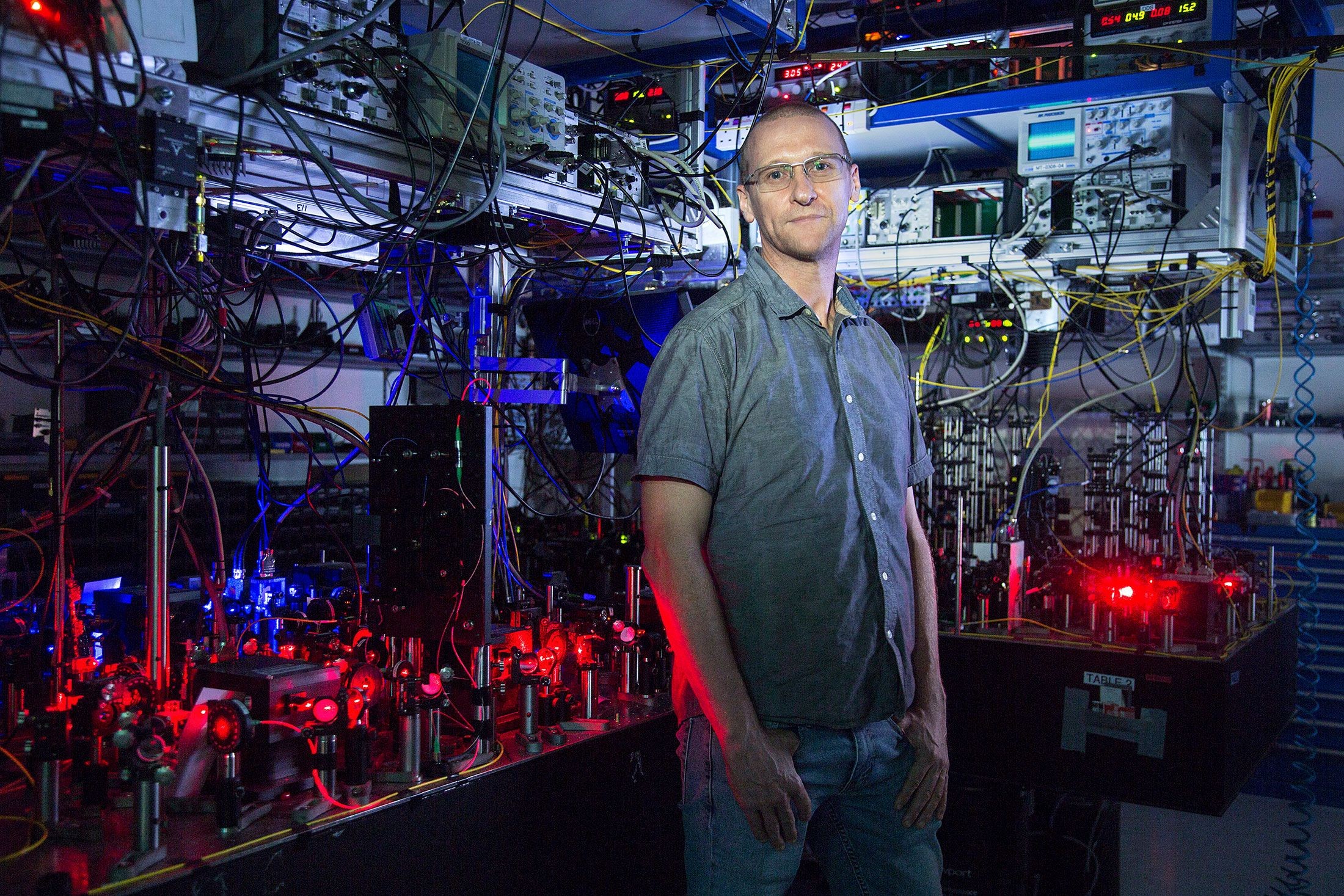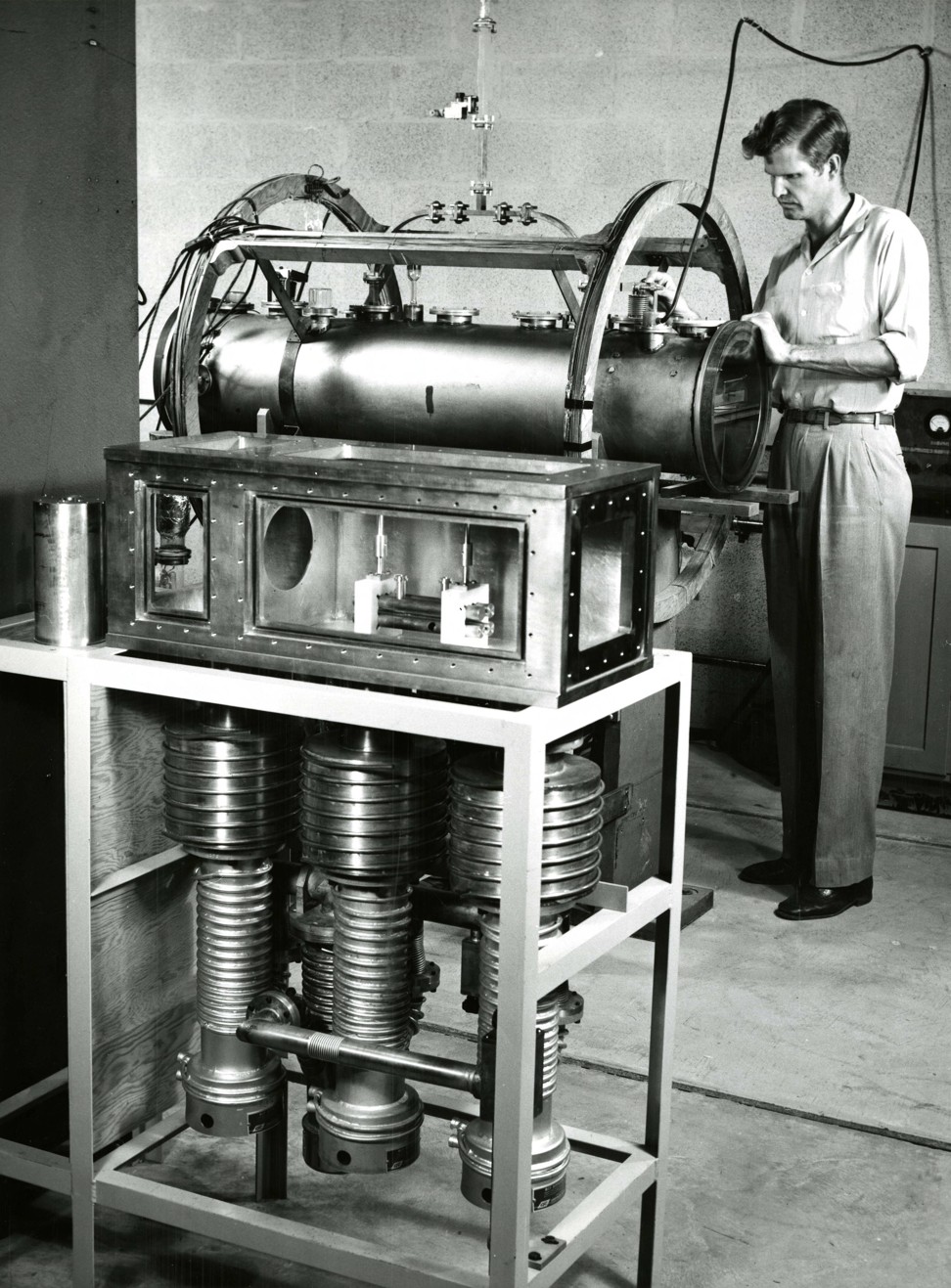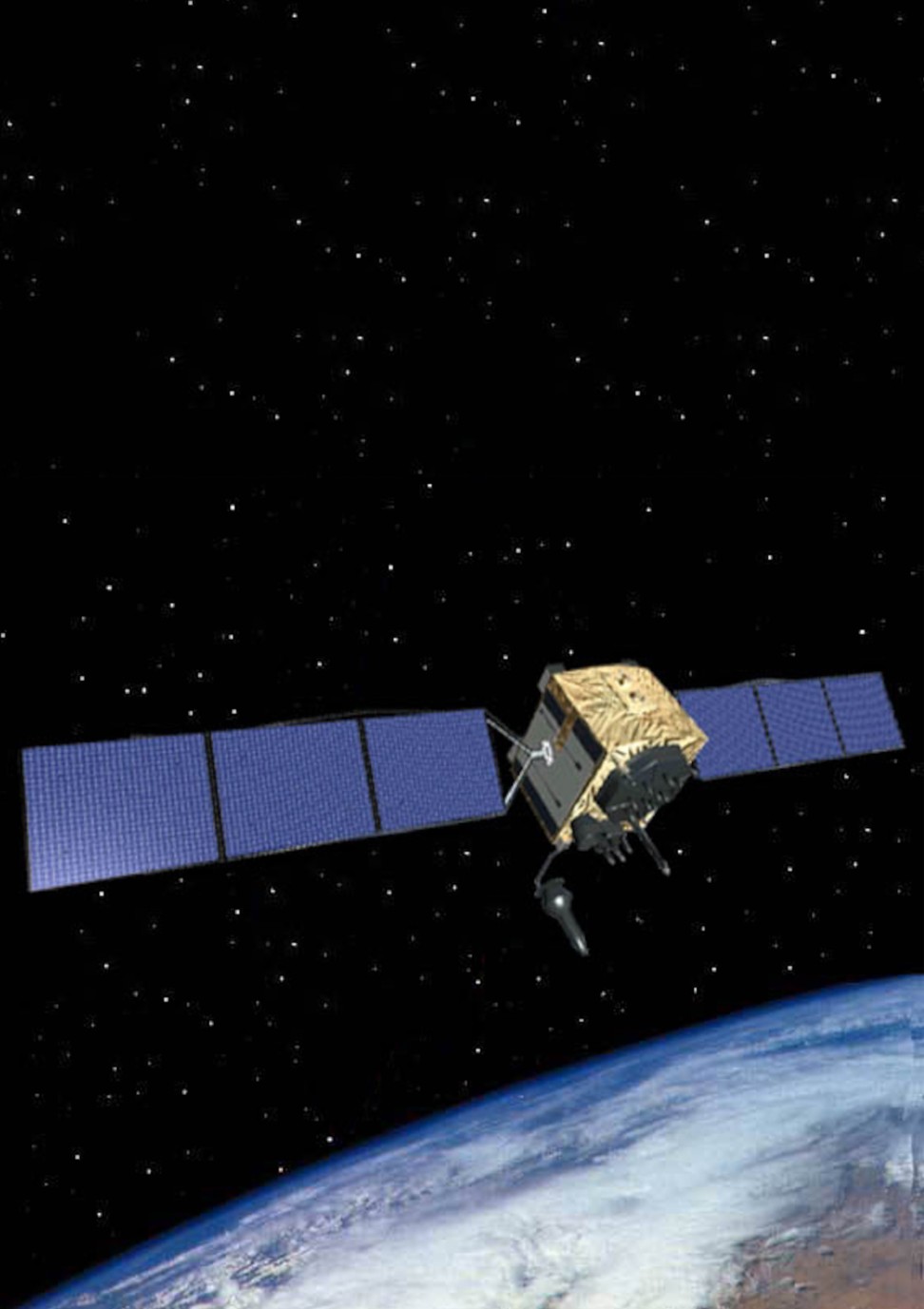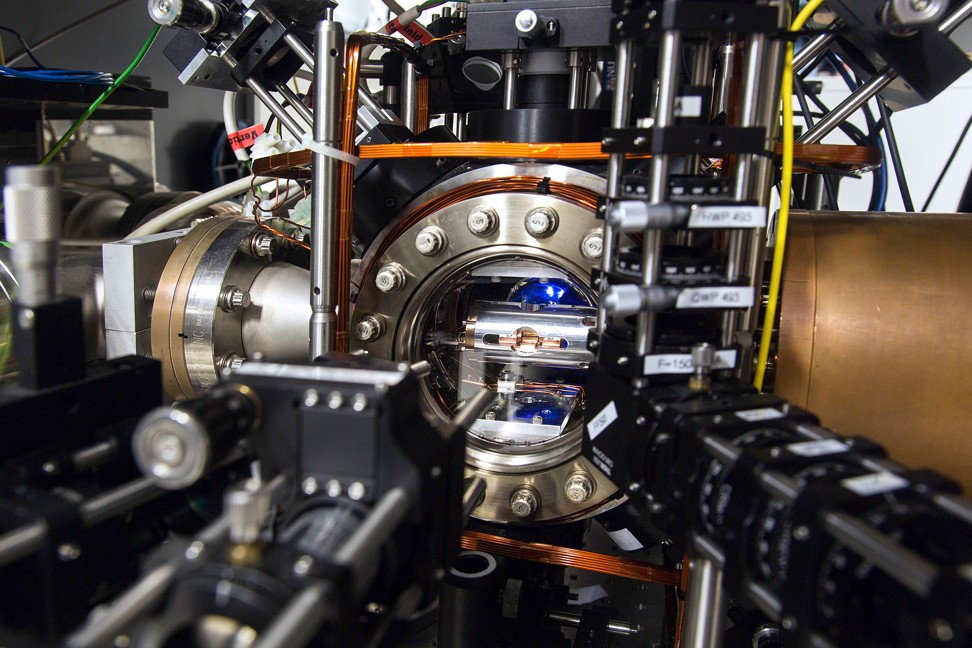
- From the scientific community to the military and the financial industry, everyone is watching keenly as atomic clocks become more accurate
The most important part of one of the most precise clocks in the world is a paper-thin, staple-size piece of lutetium. It rests inside a soundproof, vibration-proof, mini-fridge-size box, which sits atop a US$22,000 motion-dampening table. Murray Barrett, associate professor of physics at the National University of Singapore, reaches for the case to show me.
“It should be OK,” he says in his warm New Zealand accent. But then he hesitates. We are in a darkened laboratory filled with lasers whose beams bank, split and intensify through arrays of crystals and electronics. “Normally it’s OK,” he says, backing away from his still-very-much-a-work-in-progress clock. “But I’m not sure if we’re running anything or not.”
Barrett’s clock, located at the university’s Centre for Quantum Technologies, is intended to slice time into more and smaller segments than any clock before it. An analogue stopwatch can typically divide a second into 10 pieces: 0.1 second, 0.2 second, etc. The lutetium clock will, in theory, add 14 zeros to the right of that decimal point, thereby segmenting the second into (roughly) a quadrillion pieces, and remain accurate to within a second if left running for 30 billion years. Even the smallest vibrations from, say, the exhaust fans that keep the laboratory environment clean are enough to upset that precision – and with it, all the lab’s work.
So far, the potential applications for a clock with 15 decimal places of precision are theoretical and aspirational. But that’s not stopping labs around the world from competing, using different elements, to reach the same goal.

Lutetium is in some ways the least likely element to feature in a winning effort. Not only is it relatively rare in nature; because of its high cost and similarity to other elements, its known applications are also rare. Thus researchers and industry tend to pass it over. If Barrett and his lab succeed, the global market for lutetium won’t expand significantly – after all, the clock uses hardly any. Nevertheless, lutetium will quickly become the beating heart of science and the global economy.
All clocks measure time by following a recurrent event. That can mean tracking the rotation of the Earth via the shadows on a sundial, or it can mean counting the swings of a pendulum. None of these timekeeping methods can produce a measurement that is constant in all times and places, though. Temperature and humidity alter mechanical clock parts, lengthening or shortening seconds. Timekeeping based on astronomical observation is hampered by the irregularity of the Earth’s orbit around the sun.
The bulk of human history did not require much precision, so the limitations of clocks did not really pose a problem. Then, in the 19th century, atomic physics opened up the possibility of a universal, unchanging definition of time.
The idea was deceptively simple. Each atom of an element on the periodic table vibrates uniquely when bombarded by an exact frequency of radiation. So if the number of cycles of radiation necessary to stimulate an atom could be counted during the best existing non-atomic definition of a second, the world would have a new definition of the second grounded in the unchanging atom. In effect, it would have an atomic clock.
Over a period of almost two decades, scientists determined that caesium, whose vibrations are comparatively easy to observe and which exists in only one stable form and thus would not need to be purified, was the best element to use. In 1967, the General Conference on Weights and Measures, an intergovernmental organisation, replaced the old celestial definition of a second with the amount of time it takes to measure 9,192,631,770 oscillations of the microwave required to stimulate vibration of caesium-133.
Even before the atomic second was defined, there were scientific, military and commercial ventures deeply interested in taking advantage of more precise timing. The United States military was one of the earliest patrons of atomic clocks, and, in 1973, its armed forces introduced the global positioning system (GPS), a super-accurate navigation network that uses satellites outfitted with atomic clocks to measure how long it takes a signal to reach and bounce back from a receiver on Earth.

For nearly two decades, scientists around the world have been working on improved atomic clocks that stimulate atoms using visible light, which oscillates roughly 100,000 times faster than the microwaves in a caesium clock. Creating these optical clocks isn’t just a matter of switching out microwaves for lasers and caesium for another element. Instead, scientists must overcome a range of scientific and technical challenges, including the fundamental question of which element is best suited for the work of telling time.
There is no lack of candidates, including aluminium, mercury and strontium. For now, the front-runner appears to be ytterbium, which is being investigated by large, well-funded teams at NIST and labs in Europe and Asia. Late last year, NIST announced that a pair of ytterbium-based clocks had set records for precision, stability and reproducibility of results. Lutetium was a late entry to this intense and expensive competition, yet, in a relatively short time, it has proven itself a worthy and intriguing dark horse, thanks to Barrett.
Barrett did not aspire to be a clockmaker. In 2002, after completing his PhD at the Georgia Institute of Technology, in the US, where he studied atomic physics, he did a two-year postdoctoral fellowship at NIST in the quantum computing and information programme. He returned briefly to New Zealand before taking up his current position in Singapore.

His research initially focused on what he calls “quantum information stuff”, a field that marries computing to the tiny world of quantum physics. According to Barrett, he was in his office one day and “just happened to look at lutetium and got an interest in precision measurement”. He pauses at the scepticism on my face, then adds: “It really is as arbitrary as that.”
Even temperature changes so minute they wouldn’t register on earlier generations of atomic clocks can be a source of error for supersensitive optical clocks. Lutetium, it turns out, is uniquely insensitive to temperature shifts. “And I would argue,” Barrett says, “whatever atom has the least sensitivity to its environment will make the better clock.”
Standing in his lab, surrounded by home-built lasers and electronics, some of which sketch ghostly red lines in the darkness, Barrett uses two rulers of similar length as a way of explaining why a more accurate clock is necessary. The rulers, he says, can be thought of as clocks. The caesium ruler measures in centimetres but an optical clock based on lutetium “would measure in millimetres”, and therefore allow the world to be measured with greater accuracy. It might even allow the measurement of things that could never be measured before, thereby revealing and resolving fundamental questions of physics.
For example, Albert Einstein’s general theory of relativity posited that the faster you travel, the more gravity pulls on you and the more time slows down. To verify this, scientists have flown atomic clocks in space and found that they ran slower, relative to clocks on Earth. Similarly, an atomic clock on a mountaintop runs faster than one at the mountain’s base, where gravity is stronger.
Right now it’d be difficult to imagine a full-fledged optical clock developed at a price point it could be deployed all overAndrew Ludlow, physicist, NIST
If optical clocks could be shrunk to portable size, something Barrett and others are researching, those measurable shifts in time could be used to map the Earth’s topography in unprecedented detail. In theory, they might also be able to reveal mineral deposits beneath that topography.
The scientific mother lode from optical clocks would be measurements so precise they could reveal dark matter, the mysterious substance that makes up about 27 per cent of the universe’s mass. Its existence has only been inferred, because ordinary matter alone cannot explain the evolution and structure of massive objects such as galaxies. NIST’s ytterbium-based clocks are reaching levels of precision that may eventually prove sufficient to detect signatures of dark matter.
In Colorado, Andrew Ludlow, the project leader on the record-setting NIST clocks, is not celebrating yet. “Right now it’d be difficult to imagine a full-fledged optical clock developed at a price point it could be deployed all over,” he says.
Making matters more difficult, the intricacy of optical clocks means they are subject to significant downtime. For them to serve as references for a new second, much less detect dark matter signatures, they will need to be able to run uninterrupted, 24/7.

“Because of the complexity of these clocks – and the cost – a lot of the applications are situations where you don’t need a lot of them, but you need them to be really good under special conditions,” Ludlow says. “Various military applications fall into that category.”
Ludlow’s funders include the US space agency Nasa and the Defence Advanced Research Projects Agency (Darpa).
But a market for optical clocks is percolating. “I’ve been contacted by a couple of people in the financial industry with generic curiosity about optical clocks,” Ludlow says. An optical clock could potentially allow an exchange to time-stamp and order many more trades in ever smaller increments of time, a quality that would be of particular interest to high-frequency traders and those who like to foil them. In 2016, the hedge fund Renaissance Technologies filed a patent on an exchange-trading system that relies upon “atomic clocks, optical clocks, quantum clocks, Global Positioning System clocks, or any clock capable of measuring time, accurate within microseconds”.
Barrett smiles uncomfortably when I ask him about the financial industry’s interest in optical clocks. He is seated at his desk in a spacious office across from his lab, a whiteboard covered in arrows and equations beside him. He did not get into physics to find ways to time-stamp more trades. Instead, the search for precision “suits my personality”, he says, and he is devoted to improving it through the endless tinkering necessary to make any clock better. “The hard part is knowing when to stop and publish,” he says.

Barrett happily acknowledges that, for now, his lab and lutetium aren’t the leaders in the race to build the second-defining optical clock. For one thing, he isn’t nearly as well-funded as other groups. But what he lacks in resources is made up for by the properties of “my atom”, he says. “My argument is, if you can make an accurate clock in ytterbium, then you must be able to make an accurate clock in lutetium, and it should be more accurate because the properties are just better.”
Singapore’s Agency for Science, Technology and Research, a government office that sponsors R&D that could benefit the city state competitively, is helping bankroll him.
“Why do they fund it,” Barrett asks. “If you look at the history of clocks, as we make them better and better, new applications pop up or the ones we have get better and better.”
To anyone outside the clock labs, the first evidence of progress will be a new definition of a second. The soonest that can happen, officially, is at the next gathering of the General Conference on Weights and Measures, scheduled for 2022. But most observers believe there won’t be a global consensus on which element or clock design should serve as the basis for a new second until at least the 2026 meeting. For now, Barrett, like other clockmakers, remains focused on the ticking.
“That’s what you really do in the clock business,” he says. “You ask, ‘How do we make these measurements better and better?’”
Text: Bloomberg Businessweek
